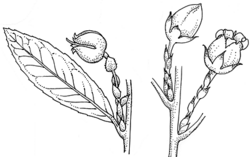Common name: Green Waxberry
Gaultheria viridicarpa J.B.Williams APNI* Synonyms: Gaultheria appressa var. glabra A.W.Hill APNI*
Gaultheria viridicarpa J.B.Williams subsp. viridicarpa APNI*
Gaultheria viridicarpa subsp. merinoensis J.B.Williams ms. APNI*
Gaultheria sp. A APNI*

Description: Spreading low shrub 0.2–0.7 m high, spreading to c. 1.6 m dia., or sometimes slender; stems glabrous or almost so, with a few scattered bristles.
Leaves narrow-elliptic to broad-ovate, 1.5–6 cm long, 6–20 mm wide, apex acute to rounded, apiculate, margins finely toothed, lamina glabrous, usually thick, leathery, the veins often impressed on upper surface; petiole 1–3 mm long.
Inflorescence 1-flowered, in upper axils or in a terminal cluster or short panicle, each peduncle with a terminal flower and 4–9 bracteoles. Sepals ovate, enlarging and becoming firm-fleshy in fruit, remaining green. Corolla 4–5.5 mm long, white. Nectary a 10-lobed ring.
Fruit, including the green calyx, 5–6 mm diam. when fresh.
Flowering: spring to early summer.
Distribution and occurrence: Grows in montane woodland in crevices of basalt rocks or on cliff faces, rarely in Nothofagus moorei rainforest; known only from Point Lookout–Majors Point area near Ebor and Mt Merino on the Qld–N.S.W. border, rare. In New South Wales, alll known plants are conserved in Lamington National Park, Limpinwood Nature Reserve and New England National Park.
NSW subdivisions: NC, NT
Threatened species: NSW BCA: Endangered; Commonwealth EPBC: Endangered
Gaultheria viridicarpa is a narrowly endemic species known from two disjunct populations: McPherson Range, Mount Merino, on the Queensland–New South Wales border, c. 20 km NW of Murwillumbah and along the Great Escarpment from near Ebor south to Point Lookout, c. 70 km E of Armidale, New South Wales. Populations occur in skeletal loam on basalt along cliff-lines of erosional calderas of Pleistocene shield volcanoes, the former on the Tweed Volcano, the latter on the Ebor Volcano. The Mount Merino population is only known along several hundred metres of cliff top at c. 1160 m altitude in a narrow strip between Nothofagus moorei closed forest and the escarpment edge, with associated species including Pittosporum oreillyanum, Tasmannia insipida, Lomatia arborescens, Podolepis monticola, Olearia elliptica, Coronidium telfordii, Xerochrysum sp. Mt Merino (S.T.Blake 22869), Leucopogon sp. Lamington (G.Leiper AQ633386) and Dendrobium kingianum. At New England sites plants have been observed on rocky sites adjacent to cliff tops, in cracks in rock faces and in rock overhangs beneath cliffs at 1400–1560 m altitude. The plants grow in Eucalyptus pauciflora shrubby open forest with Banksia integrifolia subsp. monticola,Ozothamnus whitei, Gingidia montana s. lat. and on the margin of Nothofagus moorei layered closed forest withTrochocarpa montana, Coronidium elatum subsp. minus, Xerochrysum sp. Point Lookout (I.R.Telford 12830) and Wahlenbergia telfordii.
Text by J. M. Powell, except for groups with contributors listed; edited Louisa Murray Dec 2015
Taxon concept: Flora of NSW: 3; Telford & Williams (2012)Telopea 14:77-81.
APNI* Provides a link to the Australian Plant Name Index (hosted by the Australian National Botanic Gardens) for comprehensive bibliographic data
***The AVH map option provides a detailed interactive Australia wide distribution map drawn from collections held by all major Australian herbaria participating in the Australian Virtual Herbarium project.
|


